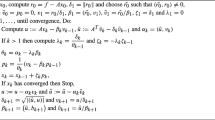Abstract
A subspace expanding technique (SET) is proposed to efficiently discover and find all zeros of nonlinear functions in multi-degree-of-freedom (MDOF) engineering systems by discretizing the space into smaller subdomains, which are called cells. The covering set of the cells is identified by parallel calculations with the root bracketing method. The covering set can be found first in a low-dimensional subspace, and then gradually extended to higher dimensional spaces with the introduction of more equations and variables into the calculations. The results show that the proposed SET is highly-efficient for finding zeros in high-dimensional spaces. The subdivision technique of the cell mapping method is further used to refine the covering set, and the obtained numerical results of zeros are accurate. Three examples are further carried out to verify the applicability of the proposed method, and very good results are achieved. It is believed that the proposed method will significantly enhance the ability to study the stability, bifurcation, and optimization problems in complex MDOF nonlinear dynamic systems.
Similar content being viewed by others
References
REDDY, C. and CHIANG, H. D. A stability boundary based method for finding saddle points on potential energy surfaces. Journal of Computational Biology, 13, 745–766 (2006)
MEINTJES, K. and MORGAN, A. Chemical equilibrium system as numerical test problems. ACM Transactions on Mathematical Software, 16, 143–151 (1990)
ZHU, M., HU, Y., and WENFENG, G. Generalization of Solovev’s approach to finding equilibrium solutions for axisymmetric plasmas with flow. Plasma Science and Technology, 20, 035,101 (2018)
LU, L. and ZHAO, S. High-quality point sampling for B-spline fitting of parametric curves with feature recognition. Journal of Computational and Applied Mathematics, 345, 286–294 (2018)
INTEP, S. A review of bracketing methods for finding zeros of nonlinear functions. Applied Mathematical Sciences, 12, 137–146 (2018)
WU, X. Improved Müller method and bisection method with global and asymptotic superlinear convergence of both point and interval for solving nonlinear equations. Applied Mathematics and Computation, 166, 299–311 (2005)
SUHADOLNIK, A. Combined bracketing methods for solving nonlinear equations. Applied Mathematics Letters, 25, 1755–1760 (2012)
SUHADOLNIK, A. Superlinear bracketing method for solving nonlinear equations. Applied Mathematics and Computation, 219, 7369–7376 (2013)
SHAW, S. and MUKHOPADHYAY, B. An improved regula falsi method for finding simple roots of nonlinear equations. Applied Mathematics and Computation, 254, 370–374 (2015)
CHEN, J. and LI, W. An exponential regula falsi method for solving nonlinear equations. Numerical Algorithms, 41, 327–338 (2006)
COSTABILE, F., GUALTIERI, M. I., and LUCERI, R. A modification of Müller’s method. Calcolo, 43, 39–50 (2006)
KUMAR, D., SINGH, A., and SRIVASTAVA, A. Various Newton-type iterative methods for solving nonlinear equations. Journal of the Egyptian Mathematical Society, 21, 334–339 (2013)
SCHLEICHER, D. and STOLL, R. Newton’s method in practice: finding all roots of polynomials of degree one million efficiently. Theoretical Computer Science, 681, 146–166 (2017)
QU, S., LIU, C., GOH, M., LI, Y., and JI, Y. Nonsmooth multiobjective programming with quasi-Newton methods. European Journal of Operational Research, 235, 503–510 (2014)
LEONG, W., HASSAN, M., and WAZIRI, M. A matrix-free quasi-Newton method for solving large-scale nonlinear systems. Computers and Mathematics with Applications, 62, 2354–2363 (2011)
BUHMILER, S. and KREJIĆ, N. A new smoothing quasi-Newton method for nonlinear complementarity problems. Journal of Computational and Applied Mathematics, 211, 141–155 (2008)
HSU, C. A generalized theory of cell-to-cell mapping for nonlinear dynamical systems. Journal of Applied Mechanics, 48, 634–642 (1981)
LI, Z., JIANG, J., and HONG, L. Noise-induced transition in a piecewise smooth system by generalized cell mapping method with evolving probabilistic vector. Nonlinear Dynamics, 88, 1473–1485 (2017)
YUE, X., XU, W., ZHANG, Y., and DU, L. Analysis of global properties for dynamical systems by a modified digraph cell mapping method. Chaos, Solitons and Fractals, 111, 206–212 (2018)
XIONG, F., SCHÜTZE, O., DING, Q., and SUN, J. Q. Finding zeros of nonlinear functions using the hybrid parallel cell mapping method. Communications in Nonlinear Science and Numerical Simulation, 34, 23–37 (2016)
CARNIEL, R. A quasi cell mapping approach to the global dynamical analysis of Newton’s root-finding algorithm. Applied Numerical Mathematics, 15, 133–152 (1994)
EASON, R. and DICK, A. A parallelized multi-degrees-of-freedom cell mapping method. Nonlinear Dynamics, 77, 467–479 (2014)
BELARDINELLI, P. and LENCI, S. An efficient parallel implementation of cell mapping methods for MDOF systems. Nonlinear Dynamics, 86, 2279–2290 (2016)
LI, Z., JIANG, J., LI, J., HONG, L., and LI, M. A subdomain synthesis method for global analysis of nonlinear dynamical systems based on cell mapping. Nonlinear Dynamics, 95, 715–726 (2019)
DELLNITZ, M. and HOHMANN, A. A subdivision algorithm for the computation of unstable manifolds and global attractors. Numerische Mathematik, 75, 293–317 (1997)
GROSAN, C. and ABRAHAM, A. A new approach for solving nonlinear equations systems. Systems, Man and Cybernetics, Part A: Systems and Humans, 38, 698–714 (2008)
ASKARI, H., SAADATNIA, Z., YOUNESIAN, D., YILDIRIM, A., and KALAMI-YAZDI, M. Approximate periodic solutions for the Helmholtz-Duffing equation. Computers and Mathematics with Applications, 62, 3894–3901 (2011)
LUO, A. and HUANG, J. Analytical solutions for asymmetric periodic motions to chaos in a hardening Duffing oscillator. Nonlinear Dynamics, 72, 417–438 (2013)
Acknowledgement
The first author Zigang LI would like to thank the China Scholarship Council (CSC) for sponsoring his study in the University of California, Merced.
Author information
Authors and Affiliations
Corresponding author
Additional information
Project supported by the National Natural Science Foundation of China (Nos. 11702213, 11772243, 11572215, and 11332008) and the Natural Science Foundation of Shaanxi Province of China (No.2018JQ1061)
Rights and permissions
About this article
Cite this article
Li, Z., Jiang, J., Hong, L. et al. A subspace expanding technique for global zero finding of multi-degree-of-freedom nonlinear systems. Appl. Math. Mech.-Engl. Ed. 41, 769–784 (2020). https://doi.org/10.1007/s10483-020-2604-6
Received:
Revised:
Published:
Issue Date:
DOI: https://doi.org/10.1007/s10483-020-2604-6
Key words
- spatial discretization
- subspace expanding technique (SET)
- parallel computing
- subdivision
- global zero finding




